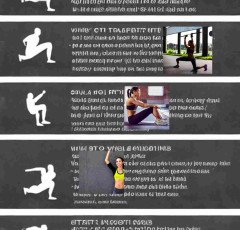Keep the subsequent in thoughts whilst you create your traning program.Think about your health goals.
Make a ordinary this is balanced. Start out small and move slowly Include exercise for your ordinary regimen. Consider such as numerous sports. Consider conducting high-interval education. Allocate time for rest. Put it in writing. One of the first-class things you can do on your health is begin a exercising routine. Exercise can help you lose weight, increase your balance and coordination, decrease your threat of growing persistent sicknesses, or even beautify your sleep styles and sense of self esteem. There is additional top information. A health software may be initiated in only 5 simple steps.
Determine your degree of fitness
You possibly have a few concept of your level of health. However, calculating and documenting your baseline fitness rankings can provide you with requirements by which to examine your development.To compare your flexibility, physical power, and body composition :-Your coronary heart fee earlier than and right after a mile (1.6 kilometers) of walking
How an awful lot time it takes to run 1.5 miles (2.Forty one kilometers) or stroll 1 mile How many pushups, either ordinary or changed, you can carry out immediately How a ways you may stretch your legs out in the front of you while seated at the ground. your waist's dimension at the top of your hips Create your exercise plan
It's simple to country that you will workout each day. You will need a plan, even though.
Keep the following in thoughts whilst you create your training program : -
Consider your health goals Are you beginning a fitness application to help shed pounds? Or do you have got every other motivation, inclusive of making ready for a marathon? Having clean dreams can help you gauge your development and live influenced.
Create a balanced ordinary. Get at least one hundred fifty mins of slight aerobic hobby or seventy five minutes of full of life cardio hobby a week, or a aggregate of mild and full of life interest. The suggestions advocate that you unfold out this exercise at some stage in the direction of a week. To provide even more health benefit and to help with weight reduction or keeping weight loss, at the least three hundred minutes a week is recommended.But even small quantities of physical pastime are beneficial. Being lively for quick durations of time during the day can add up to provide health advantage.
Do energy education physical activities for all foremost muscle corporations at the least two instances every week. Aim to do a single set of each exercise, the use of a weight or resistance stage heavy sufficient to tire your muscular tissues after about 12 to 15 repetitions.But even a bit little bit of workout is beneficial. The cumulative effects of being active all through the day can be useful in your health.At least two times every week, carry out power-schooling sports for all of the essential muscle companies. Each exercising should be finished as soon as with a weight or resistance degree that causes your muscular tissues to come to be fatigued after 12 to fifteen repetitions.Start small and circulate slowly. When you first begin exercising, proceed carefully and with warning. Consult your health practitioner or an workout therapist for help in creating a health regimen that step by step will increase your variety of movement, strength, and staying power when you have an harm or a clinical situation. Include exercising in your everyday routine. Finding the time to exercise session is probably hard. Make it easier by scheduling exercising time just like you will every other appointment. Plan to examine whilst riding a desk bound motorcycle, watch your preferred display even as strolling at the treadmill, or take a smash to go for a stroll at work. Consider along with plenty of sports. Cross-education enables prevent exercise boredom by means of blending up your workout routines. Using low-impact physical activities like cycling or water workout as go-schooling decreases your chance of overusing a particular muscle or joint or getting injured. Plan to trade between sporting activities that focus on numerous frame regions, including on foot, swimming, and electricity education.Put workout into your each day recurring. It may be hard to discover the time to exercise. Schedule your exercises like you'll any other appointment to make it less complicated. Plan to watch your preferred show whilst taking walks on the treadmill or examine whilst riding a desk bound motorbike, or take a destroy to head for a walk at paintings.Think about incorporating quite a number sports. By various your workouts, move-education allows minimize workout monotony. Utilizing low-effect sporting events as cross-training reduces your danger of overusing a specific muscle or joint or struggling an damage. Examples consist of cycling and water exercise. Exercises that target unique body components, including on foot, swimming, and electricity training, ought to be alternated. If you are going to spend money on workout system, get something so that it will be beneficial, a laugh, and simple to apply. Before shopping for your own system, you would possibly desire to check out precise types at a health facility. You might reflect onconsideration on the use of health applications for smart devices or other pastime monitoring gadgets, like ones that could reveal your heart fee, music your distance traveled, and music calories burned. Start out
You can now take movement. Keep those guidelines in mind when your exercise regimen receives started :-Start out slowly and steadily increase, Give your self lots of time to stretch or take a leisurely walk to warm up and cool down. Then choose up the pace until you may keep it for five to 10 mins without becoming too exhausted. Increase your workout time steadily as your endurance gets higher. Work your way up to exercising for 30 to 60 mins maximum days of the week.
Break matters up if essential, You can unfold out your exercising all through the day; you do not need to do it . There are also cardio advantages to shorter however more common sessions. A few brief workouts at some stage in the day may go into your time table extra readily than a single 30-minute exercise. Be progressive, You may additionally blend up your education routine with other physical activities like on foot, biking, or rowing. Do not forestall there even though. Spend a night ballroom dancing or go on a weekend walk with your own family. Find fun activities to incorporate into your health routine. Be privy to your body, Take a destroy in case you enjoy soreness, breathlessness, vertigo, or nausea. You is probably exerting too much attempt. Be adaptable, Give your self permission to take a day or off in case you're no longer feeling properly. Track your improvement
Six weeks when you begin your application, after which each few months after that, retake your private fitness assessment. You may discover that with a view to preserve getting higher, you need to exercise session for a longer time frame. Or, you is probably pleasantly surprised to examine that your degree of exercising is precisely what you want to acquire your fitness targets.
If your motivation wanes, try a different hobby or make new dreams. Additionally, working out with a pal or enrolling in a category at a gymnasium might be beneficial.
Starting a fitness routine is a crucial choice. However, it would not need to be hard. You can create a lifelong healthful habit by using well planning and taking it sluggish.

























































































 Only For The United States
Only For The United States  Echo Dot - Smart speaker with Alexa
Echo Dot - Smart speaker with Alexa  Online Technology Classes
Online Technology Classes  Crocs
Crocs  The Secret Email System
The Secret Email System  LCD Writing Tablet
LCD Writing Tablet  Samsung Mobile
Samsung Mobile  Rakhi
Rakhi  Top Rated From Amazon
Top Rated From Amazon  Smart Watches
Smart Watches  Acer Laptop
Acer Laptop  Best Phone
Best Phone  Smart Doorbell
Smart Doorbell  Best Robotic Vacuum Cleaners
Best Robotic Vacuum Cleaners  Realme Smart Phone
Realme Smart Phone  Men Clothing
Men Clothing  NordPass
NordPass  Hanging Lights For Living Room
Hanging Lights For Living Room  Air Purifier for Home
Air Purifier for Home  Dual USB Car Charger
Dual USB Car Charger  SOFAS
SOFAS  Graphics & Design
Graphics & Design  Adidas Shoes
Adidas Shoes  Dell Laptop
Dell Laptop  Amazon Best Selling Products
Amazon Best Selling Products  Healthy Ingredients
Healthy Ingredients  ASUS Laptop
ASUS Laptop  Unreal Engine 5 For Beginners Learn The Basics Of Virtual Production
Unreal Engine 5 For Beginners Learn The Basics Of Virtual Production  TitTok Revolution
TitTok Revolution  Door Handle Collection
Door Handle Collection  NordLocker
NordLocker  SEO Checklist
SEO Checklist  Kitchen Tap
Kitchen Tap  BEST SELLER TOP10
BEST SELLER TOP10  Motion Sensor Light
Motion Sensor Light  ASPINAL LONDON
ASPINAL LONDON  Apple iPhone
Apple iPhone  Essentials for Gamers
Essentials for Gamers  Pet Care Products
Pet Care Products  Digital Voice Recorder
Digital Voice Recorder  Hello Theme
Hello Theme  Sennheiser
Sennheiser  RPM 3.0
RPM 3.0  Wall Lamp
Wall Lamp  Wireless Gaming Mouse
Wireless Gaming Mouse  Best Selling Books
Best Selling Books  Wireless Bluetooth Earphones
Wireless Bluetooth Earphones  NordVPN
NordVPN  Women Fashion
Women Fashion  iPhone cable
iPhone cable  Hot Bags For Pain Relief
Hot Bags For Pain Relief  Artificial Intelligence
Artificial Intelligence  One World Collection
One World Collection  Puma (Clothing & Accessories)
Puma (Clothing & Accessories)  All Wireless Products
All Wireless Products  Prime Video
Prime Video  Unlimited access to classes on illustration, photography, design, film, music
Unlimited access to classes on illustration, photography, design, film, music  Duke T Shirts
Duke T Shirts  Stylish Sneakers by Red Tape
Stylish Sneakers by Red Tape  Bathroom Mirrors
Bathroom Mirrors  Best Sellers On Amazon
Best Sellers On Amazon  Online Marketing
Online Marketing  Creative Brief For Video Shoot
Creative Brief For Video Shoot  Favorite Company (Cuelinks)
Favorite Company (Cuelinks)  Kitchen Daily Use
Kitchen Daily Use  ELECTRONIC ACCESSORIES
ELECTRONIC ACCESSORIES  1150+Trendy kids coloring pages Bundle
1150+Trendy kids coloring pages Bundle  Best Home Appliances
Best Home Appliances  HP Laptop
HP Laptop  Wristbands
Wristbands  The Click Engine
The Click Engine  4k Projector For Home
4k Projector For Home  Home Decor Items
Home Decor Items 


















